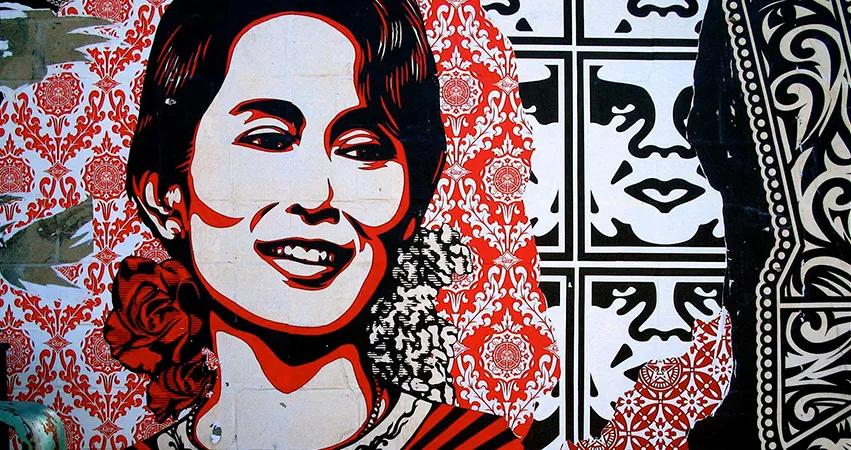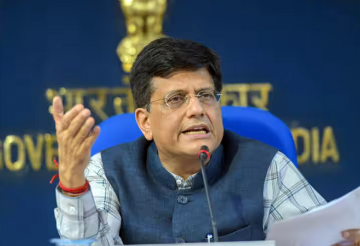The election of Htin Kyaw, a trusted aide of NLD leader Aung San Suu Kyi, as the president has put Myanmar firmly on the path of a democratic transition. As Myanmar settles down to a popularly elected government after over three decades of military rule, neighbours, India and China have an opportunity to end the predicament and engage Myanmar in a spirit of cooperation rather than competition.
Suu Kyi who will take over as the foreign minister in the new government had submitted in her interview to an Indian T.V. channel in the run up to the general elections last year that Myanmar could help India and China overcome its problems and steer through relations between her two neighbours. Such a statement from the democracy icon at a time when Myanmar pivot’s West, is a wake-up call for Myanmar’s two large neighbours having civillisational links tracing back to centuries.
Signing of the Panchasheel Treaty of Friendship and Peace in 1954 laid the foundation of trilateral relations between China, India and Myanmar. The 60th anniversary celebrations of the signing of the treaty in 2014 saw leaders from the three countries affirming their commitment towards the five principles of Buddhism enshrined in the treaty. But, this commemorating this important landmark year saw unmatched initiative by China with little zeal from India.
BCIM in limbo
China’s renewed thrust on the intensifying its relations with India and Myanmar seem apparent with initiatives like the Bangladesh, China, India, Myanmar (BCIM) Economic Corridor part of China’s larger One Belt One Road initiative (OBOR). China is believed to have formulated the OBOR strategy as the lynchpin of her engagement with the world.
Initially, New Delhi seemed interested in the BCIM Economic Corridor, but soon after the change of guard at the centre, the BCIM-EC was put on the back-burner. Little progress has since been made as New Delhi believes that BCIM-EC concurs with China’s String of Pearls strategy that is believed to isolate India by encircling her in the Indian Ocean Region.
The incremental progress in China-India-Myanmar’s relations has not really resulted in intensifying economic cooperation. At a time when Myanmar’s pivots towards US, EU, Japan and its partners in East Asia, the China-India-Myanmar triangle is likely to be affected in many ways.
Emerging trade blocs
The U.S. led Trans-Pacific Strategic Economic Partnership a Free-Trade Agreement between 12 Pacific-rim countries that was signed in February already has four ASEAN members Singapore, Brunei, Vietnam and Malaysia as signatories. The TPP agreement also has ASEAN+6 members like Japan, Australia and New Zealand as signatories. With Indonesia and Thailand keen on joining the TPP, Myanmar is likely to feel it imperative to consider joining the TPP at a later stage.
India has focused on developing her relations with ASEAN, a key to India’s ‘Act East’ policy, earlier known as Look East, initiated in the 1990’s to foster strategic and economic cooperation with East Asian countries. The two way trade between the India and ASEAN touched nearly $80 billion in 2014-15, though the expected potential was set for $100 billion by December 2015 and $200 billion by 2022.
Both, India and China are not keen on joining the mega regional trade pact like TPP. India instead has concentrated its energies in concluding the Regional Comprehensive Economic Partnership (RCEP) with ASEAN+6. Through the RCEP, India hopes to negotiation the terms of its entry into the TPP.
Development finance
Myanmar senses an opportunity in the Beijing headquartered Asian Infrastructure and Investment Bank (AIIB) where India is the second largest stakeholder. Infrastructure in Myanmar is said to get a boost by the loan approvals that the bank is said to dish out starting by the end of the year. Though, it is China-led initiative, both India and Myanmar have joined the AIIB.
The AIIB has been floated as an alternative to the World Bank and Asian Development Bank; critics argue that the latter’s terms for providing development finance is heavily loaded in favour of developed nations. Through the $100 billion initiative, China hopes to address the hegemony of U.S. in global financial institutions.
Myanmar needs finance for developing infrastructure in the underdeveloped nation and AIIB could ease out the pressures on Nay Pyi Taw for meeting the infrastructural demands of retaining foreign investors and attracting more FDI in the country. New Delhi sees this as a bargaining chip in other multilateral trade and financial organizations.
Need for new synergies
China is Myanmar’s largest trading partner and has invested heavily in the oil and gas exploration, mining, hydropower and infrastructure projects. Beijing is constructing the Kyaukphyu SEZ in the Rakhine state that would also include an include textile and garment factories and construction material and food processing industries. The project is said to contribute $10 billion every year.
India is developing two big projects in Myanmar, the Kaladan Multimodal Transit Transport Project and the Thailand-Myanmar-India Trilateral Highway. Indian banks and public sector oil and gas companies have also had their presence in Myanmar. New Delhi has also announced $500 million line of credit for Myanmar.
As both, China and India hope to increase their footprint in Myanmar pivoted towards the West, they are faced with the imperative of developing newer synergies to engage together with Myanmar. Civillisational links between the three countries have outlived the long of internment of relations and once again present an opportunity for nurturing diplomacy and trade.
This commentary originally appeared in FORE India.
The views expressed above belong to the author(s). ORF research and analyses now available on Telegram! Click here to access our curated content — blogs, longforms and interviews.




 PREV
PREV


